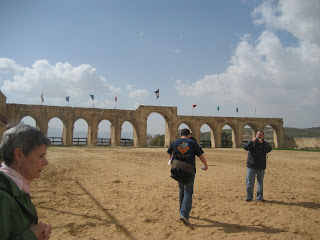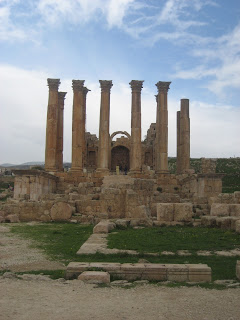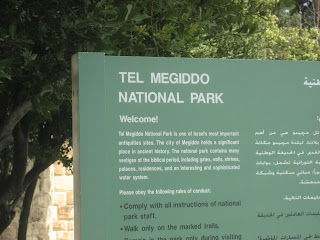Unfortunately, our meeting with Jordanian Christians did't work out, so we ended up spending most of the day exploring Jerash (or Gerasa, depending on how you choose to anglicise the word). Jerash is an ancient Roman city that was forgotten for centuries, but has been excavated in recent years. Most Westerners don't know about it, probably because it's not in a Western country. We were told that it's better preserved than Pompeii, a claim of which we were all skeptical, until we saw it. Wow! It's incredible how much of this has been excavated just as it was with no need for restoration!
Among the amazing thing we saw were Hadrian's Triumphal Arch, the Hippodrome (an ovular track where chariot races would be held, like the Circus Maximus in Rome), temples to Artemus and Zeus, two outdoor ampitheaters (the smaller one possibly being the meeting place for the city's parliament), a very ornate marketplace, and the town centre where the north-south and east-west main streets meet (think Monument Circle in Indianapolis).
While Jerash never shows up explicitly in the New Testament, there may be some tangental references. The Gerasene Demoniac (Mark 5) may have been from here, and after Jesus walked on water, he and the disciples may have headed to this region (Matthew 14:34). Also, according to Paul's letters (but not Acts), he went through the Decapolis (Greek for "ten cities" of which Gerasa was one) region/Arabia on his way from Damascus to Jerusalem (Galatians 1:17).
Pics w/ occasional comments are below.
The ancient Roman manhole cover.
Part of the edifice of the Temple of Artemis. If you climbed up the steps, walked back across the wall and down a very narrow set of steps, you would reach...
This particular opening, which would have been a display stand for statues. Not the smartest thing I've ever done, but it was cool!
The "inner sanctum" of the Temple of Artemus. The layout is pretty much identical to the Second Temple in Jerusalem built by Herod the Great, so this is like the view out from the Holy of Holies.
Of course, I had someone take a picture of me speaking on the stage of the ampitheatre. Anyone who knows me will not be shocked by this at all.
Yes, this is a band of Arabs that includes bagpipes. No, I don't know why.
Me at the top of the other ampitheater, overlooking the city center.
An ancient bridge, still in use in the modern city of Jerash. Notice the minaret in the background.
Amazing chicken schwarma sandwiches/rollups that hit the spot after walking over four miles and lots of steep steps through the ancient city.
That's all for today. Tomorrow brings trips to Mt. Nebo, Qumeran, the Jordan River where Jesus was baptized by John, and crossing the border from Jordan back into the West Bank, which will likely be eventful. Until then, take care!




























































